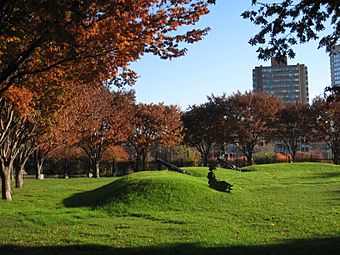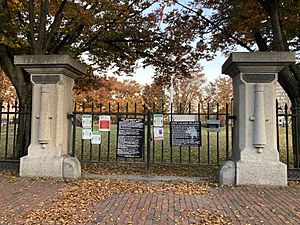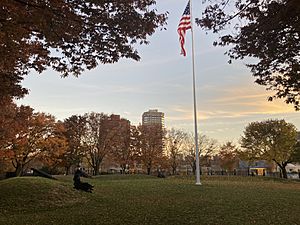Fort Washington (Massachusetts) facts for kids
Quick facts for kids |
|
|
Fort Washington
|
|

Fort Washington
|
|
| Location | 95 Waverly St., Cambridge, Massachusetts |
|---|---|
| Area | 0.7 acres (0.28 ha) |
| Architect | Richard Gridley |
| Architectural style | Three Gun Half Moon Battery |
| NRHP reference No. | 73000284 |
| Added to NRHP | April 3, 1973 |
Fort Washington, also known as Fort Washington Park, is a special historical place in Cambridge, Massachusetts. Soldiers from the Continental Army built it in November 1775. This happened under the orders of George Washington, who later became the first President of the United States.
This fort is very important because it is the oldest military fort still standing from the American Revolutionary War. It is also the only fort left from the Siege of Boston, a key event in the war. Fort Washington was added to the List of Registered Historic Places in Massachusetts on April 3, 1973. This means it is officially recognized as a significant historical site.
Contents
History of Fort Washington
Building the Fort During the Revolution
In November 1775, George Washington wrote a letter from Cambridge. He mentioned that he had ordered "two three gun half moon batteries to be thrown up for occasional use." These small forts were built to help protect the area.
At this time, a brave officer named Henry Knox was on an important mission. He was traveling to Fort Ticonderoga to bring back large cannons. These cannons were needed for the Continental Army. This difficult journey was known as the noble train of artillery. The soldiers at Fort Washington needed to practice building places where these big guns could be set up quickly.
Fort Washington After the War
Years later, in 1857, the City of Cambridge bought the land where Fort Washington stood. They decided to restore the fort. As part of this restoration, three 18-pounder cannons were brought from an old fort called Fort Winthrop. This fort was located on Governor's Island.
To protect the historic site, a beautiful fence was designed. It was made of granite and iron by an architect named John R. Hall. The city worked with the Commonwealth of Massachusetts to restore the fort. They also built a strong fence and put up a flag-staff.
The Secretary of War gave the city three 18-pound cannons. The Secretary of the Navy provided the carriages for these guns. The Massachusetts State Legislature even voted to give $2,000 to help with the project. They wanted to make sure the fort would always be open to the public.
In 1965, a law was passed that allowed Cambridge to transfer the park to the United States government. This was done to recognize it as a historic landmark. Today, Fort Washington remains a city park. It is also a special historic district within Cambridge. The park was rededicated on October 3, 2009, after more restoration work. What you see there now are mostly grassy areas, not big, strong fortifications.
Cannons at the Fort
The cannons you see at Fort Washington are 18-pounders. These guns were made during or shortly after the American Revolution. For example, two similar 18-pound cannons in Stonington were cast in 1781. They were made in Salisbury, Connecticut. There are also two 18-pound cannons at Mount Defiance in Ticonderoga, New York, which are also from the Revolution.
The three 18-pounders at Fort Washington came from an older Fort Warren. This fort was on Governor's Island. When a new Fort Warren was built on George's Island, these older cannons were moved.
In 1942, a man named Mr. Marcus Morton learned more about these cannons. He found out that the gun carriages were made by the West Point Foundry on the Hudson River. City records showed that it cost Cambridge $13.50 to move these guns from Governor's Island.
These cannons look very similar. They are numbered 45, 36, and 40. Their weights are also recorded. The hole where the cannonball goes, called the bore, is about 5 5/8 inches wide. This size allowed for an 18-pound cannonball to fit, with a little extra space.
Images for kids






